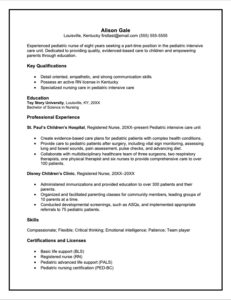Nursing Resume Examples and Writing Tips

Whether you’re searching for your first nursing job or you’ve decided to look for another position after having been in the field for years, one thing is inevitable — you need a top-notch resume. If you just felt your stomach tighten, relax. We have an easy-to-follow formula to show you how to write a nursing resume. Plus, you can take a look at the nursing resume examples linked to this page for inspiration.
Nursing Resumes Must Be Customized
Resumes, like cover letters, are not universal. To improve your chances of getting interview invitations, you need to customize your resume to each job you’re interested in pursuing. It only takes a few word adjustments here and there, but the payoff can be substantial.
Start with your basic resume. Carefully read through the job ad and be sure to use the exact wording from the ad. If the employer uses an automated tracking system, resumes with the right keywords will stick out from the recruiter’s pile. For example, if you have experience working in a nursing home, but the ad calls it “long-term care experience,” go with their keyword of “long-term care.”

Nursing Resume Examples
- Aesthetic nurse resume
- Cardiac nurse resume
- Caregiver resume
- Cath lab nurse resume
- Clinical nurse specialist resume
- CNA resume
- Critical care nurse resume
- CRNA resume
- Dermatology nurse resume
- Dialysis nurse resume
- Director of nursing resume
- ER nurse resume
- Flight nurse resume
- GNA resume
- Home health aide resume
- Home health nurse resume
- Hospice nurse resume
- ICU nurse resume
- Infusion nurse resume
- Labor and delivery nurse resume
- LNA resume
- LPN resume
- LVN resume
- Medical assistant resume
- Med-surg nurse resume
- Neonatal nurse resume
- New grad nurse resume
- NICU nurse resume
- Nurse case manager resume
- Nurse educator resume
- Nurse manager resume
- Nurse midwife resume
- Nurse navigator resume
- Nurse practitioner resume
- Nursing student resume
- Occupational health nurse resume
- Oncology nurse resume
- Operating room nurse resume
- PACU nurse resume
- PCU nurse resume
- Pediatric nurse resume
- Postpartum nurse resume
- Psychiatric nurse resume
- RMA resume
- RN resume
- School nurse resume
- SRNA resume
- STNA resume
- Surgical tech resume
- Telemetry nurse resume
- Trauma nurse resume
- Travel nurse resume
How to Write a Nursing Resume
1. Get Organized
Before you open your laptop (or a notepad, if you’re old-school), take some time to find the info you’ll need to write your resume. This includes addresses of employers and schools, dates, and the like. Gathering this in advance means you don’t have to break your stride to go on a treasure hunt. If you have previous nursing resumes, grab them too.
2. Write the Individual Resume Sections
Wondering what should be included on a nursing resume? These are the main sections that employers will be looking for. Take your time crafting each one to accurately reflect your skills and training.
Header
All nursing resume examples start with a clear header. Along with your name and certification initials, put your contact information up top. But what does that include exactly? Besides your name and credentials, your resume header should include:
- Your current city, state, and zip code (optional). There is no need to use your full address; it can be included in your cover letter or provided after an interview.
- Your cell phone number, since that will be a fast way to reach you.
- Your email address. Here’s some advice about email: if you currently have a “creative” email address like MomaLikesCats@email.com, take this opportunity to create something more professional or generic, like the first letter of your first name and full last name.
- Your LinkedIn profile page. You’ll find that current nurse resume samples include them. If you don’t have a LinkedIn page, get one. It is a great place to store your updated resume and another place people can message you. You can customize your LinkedIn URL with your name instead of a string of numbers.
John Doe, RN
Anytown, MA
555-555-5555 | jdoe@mail.com | linkedin.com/jdoe
Credentials
Wondering how to list nursing credentials on a resume? Here’s a note about what goes first on a resume, RN or BSN, etc. Always order the highest non-nursing degree first, followed by the highest nursing degree. So, a registered nurse who has a BSN and a master’s degree in education orders her credentials as such: Jane Doe, MEd, BSN, RN. If you have a doctorate and a master’s degree, omit your baccalaureate degree.
Besides the letters after your name, add a line under your contact info stating your credentials and specialty. Here’s an example:
Jane Doe, MEd, BSN, RN
Anytown, MA
555-555-5555 | jdoe@mail.com | linkedin.com/jdoe
Registered Nurse | Specializing in Geriatric Nursing
Professional Summary
A professional summary is a brief paragraph that introduces you to the hiring manager. The key word is brief, meaning three or four lines of text. Your professional summary is an introduction that should help a hiring manager or recruiter decide if they want to continue reading. It’s similar to a resume objective, but more focused on your qualifications. What past work or accomplishments are you the most proud of? What are you focused on within your specialty? What are you hoping to find in your job search? Example:
“Dedicated, experienced, and compassionate RN with 9 years of experience working in a busy metropolitan hospital. Calm and reassuring nature, with a special emphasis on soothing nervous pre-operative patients. Solid verbal communication skills and ability to translate technical medical information into understandable language to educate patients and their families.”
Key Skills
Consider these your vital signs. Don’t make a recruiter go through each job in your history to find your key skills and accomplishments. Make it easy for them by putting a bulleted list (two or three columns of three to five skills each should suffice) under your summary.
Not sure which skills to include? Compare your skills to those that show up in the job ad you’re answering. Make sure the matching skills are included in your list. And look at both the hard and soft skills that are listed on other nursing resume examples.
Job History
Job histories traditionally appear at the top of nurse resume samples. List your jobs in reverse chronological order, with your current or most recent position first. For each entry, include:
- Employer or facility name
- Its city and state
- Your job title
- A description of your responsibilities expressed as achievements, using numbers
For example, if you were responsible for activities in a nursing home, describe how you were successful in a quantifiable way. Instead of saying you “organized exercise classes,” you might say you “redesigned a weekly exercise program for 70 residents that increased participation by 50%.”
Education
Nursing resume examples typically place education typically at the bottom. As a nurse, you may have more than one school and major to list in this section, plus special training and certifications. Place your college or university degrees up top in a similar format as your job history according to these best practices:
- Include the name of the school, city, and state.
- List your degree (BSN, ADN) and major. Because of EEOC laws, your graduation year is optional if you would rather keep your age private.
- List training, certificates, certifications, and nursing-related honor societies.
Example:
University of Southern California – Sacramento, CA
Bachelor of Science in Nursing
Pediatric Anesthesia Rotation at Mercy General Hospital in Sacramento
Completed pediatric airway management course
3. Proofread
Think of this like a panel review for your resume. Always proofread before you let your resume hit the streets. Better yet, have a colleague, teacher, or mentor take a look. A fresh set of eyes can catch things that you might overlook.
4. Scrub Your Final Version
You’re ready to get your resume out there. Be sure it’s easy to read by using no more than two fonts. Use italics sparingly and avoid underlines and boldface. Look at the nursing resume templates we link to for ideas on spacing, format, etc.
Your Resume Is Ready to Work. Are You?
You’ve followed our formula and checked out nursing resume examples to get inspired. Ready to find career opportunities that interest you? IntelyCare makes it easy. Put that new resume to work by checking out great nursing jobs available right now.
Latest Jobs
-
AFC Urgent Care Medical Assistant Somerset New Jersey at American Family Care
-
AFC URGENT CARE SOMERSET – ADVANCED PRACTICE PROVIDER (APP) NP/PA at American Family Care
-
Charge RN – Med Surg, FT Nights, Sign-On Bonus up to $10K at Piedmont Healthcare
-
CMA Float – Women’s Health Specialists Clinic – Full Time , Days at Texas Health
-
STAFF NURSE – Med/Surg (General) – Mount Sinai West – Full Time Night at Mount Sinai Health Systems

